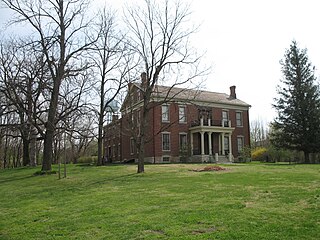
The Battle of Lexington State Historic Site is a state-owned property located in the city of Lexington, Missouri. The site was established in 1958 to preserve the grounds where an American Civil War battle took place in 1861 between Confederate troops led by Major-General Sterling Price and federal troops led by Colonel James A. Mulligan. The site offers a short battlefield loop trail, picnicking, and tours of the battlegrounds and Oliver Anderson mansion.

The Thomas Hart Benton Home and Studio State Historic Site is a state-owned property located at 3616 Belleview, Kansas City, Missouri, that preserves the house and studio of Missouri artist Thomas Hart Benton. The historic site was established in 1977 and is managed by the Missouri Department of Natural Resources. Tours are provided that show the furnished house and studio as Benton left it when he died on January 19, 1975. The site was listed on the National Register of Historic Places in 1980.
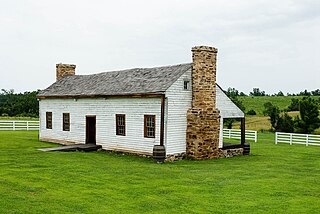
Nathan and Olive Boone Homestead State Historic Site, located two miles north of Ash Grove, Missouri, is a state-owned property that preserves the home built in 1837 by Nathan Boone, the youngest child of Daniel Boone. The Nathan Boone House, which was listed on the National Register of Historic Places in 1969, is a 1+1⁄2-story "classic" saddle-bag pioneer log house, constructed of hand-hewn oak log walls that rest on a stone foundation. Established in 1991, the historic site offers an interpretive trail plus tours of the home and cemetery.
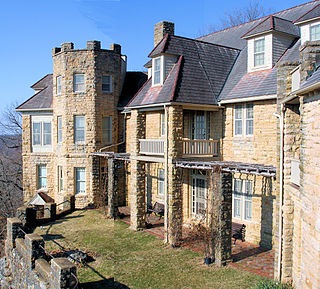
Bothwell Lodge State Historic Site is a state-owned property located north of Sedalia, Missouri, United States, preserving the 31-room, 12,000-square-foot summer home, Bothwell Lodge, built for Sedalia attorney John Homer Bothwell. The site offers tours and trails for hiking and mountain biking. It is administered by the Missouri Department of Natural Resources.
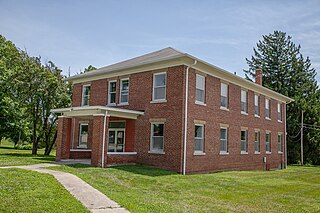
The Confederate Memorial State Historic Site is a state-owned property occupying approximately 135 acres (55 ha) near Higginsville, Missouri. From 1891 to 1950, the site was used as an old soldiers' home for veterans of the Confederate States Army after the American Civil War. The Missouri state government then took over operation of the site after the last veteran died in 1950, using it as a state park. In 1981, a cottage, a chapel, and the Confederate cemetery were listed on the National Register of Historic Places as the Confederate Chapel, Cemetery and Cottage. The chapel was moved from its original position in 1913, but was returned in 1978. It has a tower and a stained glass window. The cottage is a small wooden building, and the cemetery contains 723 graves. Within the cemetery is a monument erected by the United Daughters of the Confederacy which is modeled on the Lion of Lucerne. In addition to the cemetery and historic structures, the grounds also contain trails, picnic sites, and fishing ponds.

Mastodon State Historic Site is a publicly owned, 431-acre (174 ha) archaeological and paleontological site with recreational features in Imperial, Missouri, maintained by the Missouri Department of Natural Resources, preserving the Kimmswick Bone Bed. Bones of mastodons and other now-extinct animals were first found here in the early 19th century. The area gained fame as one of the most extensive Pleistocene ice age deposits in the country and attracted scientific interest worldwide.

Deutschheim State Historic Site is a state-owned property located in Hermann, Missouri, United States, preserving historic houses and other structures, such as a barn and winery, built and used by German immigrants in the middle 19th century. The architecture covers a range of contemporary styles brought from Germany and interpreted in the United States, and the houses have furnishings reflective of mid-century German families in Missouri. The site includes grapes planted in one of the original vineyards and the site of a printing press. The buildings include exhibits of tools and artifacts of the period, giving a picture of the immigrant journey to Missouri, daily life, and German-Missourians' contributions to the Union during the American Civil War. Tours of the grounds are offered for the public. The site was acquired by the state in 1978 and is managed by the Missouri Department of Natural Resources.

Watkins Mill is a preserved woolen mill dating to the mid-19th century, located near Lawson, Missouri, United States. The mill is protected as Watkins Woolen Mill State Historic Site, which preserve its machinery and business records in addition to the building itself. It was designated a National Historic Landmark and added to the National Register of Historic Places in 1966 in recognition for its remarkable state of preservation. The historic site is the centerpiece of Watkins Mill State Park, which is managed by the Missouri Department of Natural Resources.

Sandy Creek Covered Bridge State Historic Site is a publicly owned property in Jefferson County, Missouri, administered by the Missouri Department of Natural Resources, preserving the Sandy Creek Covered Bridge. The bridge is one of four remaining covered bridges in Missouri, which once numbered about 30. It is a relatively rare example of a Howe truss bridge, one of three in Missouri. The covered bridge is named for Sandy Creek, which it crosses, and was added to the National Register of Historic Places in 1970.

The Dillard Mill State Historic Site is a privately owned, state-administered property on Huzzah Creek in Crawford County, Missouri, that preserves a water-powered gristmill. The 132-acre (53 ha) site has been operated as a state historic site by the Missouri Department of Natural Resources under a lease agreement with the L-A-D Foundation since 1975. The site was listed on the National Register of Historic Places in 2015.

Gov. Daniel Dunklin's Grave is a Missouri state park at Herculaneum, Missouri, preserving the gravesite of Daniel Dunklin, who was governor of Missouri during the mid-1830s. Dunklin died in 1844 and was buried on his family estate, but was reinterred in 1885 when most of the estate he was buried on was sold. In 1965, the state of Missouri took control of the site to serve as a memorial to Dunklin, who is credited as the father of Missouri's public education system. The site covers 1.37 acres (0.55 ha) and is operated by the Missouri Department of Natural Resources. The cemetery is surrounded by limestone walls and overlooks the Mississippi River.

The First Missouri State Capitol State Historic Site is a state-owned property in St. Charles, Missouri, preserving the building that served as Missouri's capitol from 1821 to 1826. The site is part of the St. Charles Historic District in the city's Riverfront neighborhood. It was acquired by the state in 1960 and was added to the National Register of Historic Places in 1969.

The Harry S Truman Birthplace State Historic Site is a state-owned property in Lamar, Barton County, Missouri, maintained by the Missouri Department of Natural Resources, preserving the 1+1⁄2-story childhood home of Harry S. Truman, the 33rd President of the United States. The future president was born here on May 8, 1884, in the downstairs southwest bedroom. The home was purchased by the state in 1957 and dedicated as a historic site in 1959 at a ceremony attended by Truman himself. The site was added to the National Register of Historic Places in 1969.
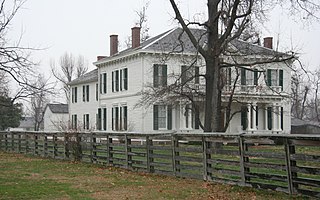
The Hunter-Dawson State Historic Site is a state-owned property in New Madrid, Missouri, maintained by the Missouri Department of Natural Resources as a historic house museum and state historic site. The Hunter-Dawson House was added to the National Register of Historic Places in 2012.
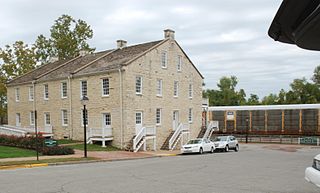
Jefferson Landing State Historic Site is a historic district maintained by the Missouri Department of Natural Resources encompassing several state-owned properties in Jefferson City, Missouri, United States. The historic site includes the Christopher Maus House, the Union Hotel, and the Lohman's Landing Building, which was listed on the National Register of Historic Places in 1969.
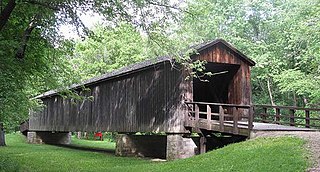
Locust Creek Covered Bridge State Historic Site is a publicly owned property in Linn County, Missouri, maintained as a state historic site by the Missouri Department of Natural Resources. Also called the Linn County Bridge, the covered bridge is located about 3 miles (4.8 km) east of Meadville, Missouri. At a length of 151 feet (46 m) with a width of 16 ft 8 in (5.08 m) it is the longest of the four remaining covered bridges in the state of Missouri. It was listed on the National Register of Historic Places in 1970.

The Mark Twain Birthplace State Historic Site is a publicly owned property in Florida, Missouri, maintained by the Missouri Department of Natural Resources, that preserves the cabin where the author Samuel Langhorne Clemens was born in 1835. The cabin is protected within a modern museum building that also includes a public reading room, several of Twain's first editions, a handwritten manuscript of his 1876 novel The Adventures of Tom Sawyer, and furnishings from Twain's Connecticut home. The historic site is adjacent to Mark Twain State Park on a peninsula at the western end of man-made Mark Twain Lake. The cabin was listed on the National Register of Historic Places in 1969.

Sappington Cemetery State Historic Site is a Missouri state historic site located approximately five miles (8.0 km) southwest of Arrow Rock in Saline County. The cemetery houses the graves of John Sappington and two of his sons-in-law, Meredith Miles Marmaduke and Claiborne Fox Jackson, who each served as governor of Missouri before the American Civil War.

Towosahgy State Historic Site (23MI2), also known as Beckwith's Fort Archeological Site, is a large Mississippian archaeological site with a Woodland period Baytown culture component located in Mississippi County, Missouri, United States. It is believed to have been inhabited from c. 400–1350 CE. The site is maintained by the Missouri Department of Natural Resources as a state historic site. The name Towosahgy is an Osage word which means "old town". It is not known if members of the historic Osage people, who dominated a large area of present-day Missouri at the beginning of the 19th century, ever occupied the site. The site was acquired by the Missouri state park system in 1967 and added to the National Register of Historic Places in 1969 as NRIS number 69000113.























